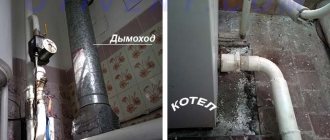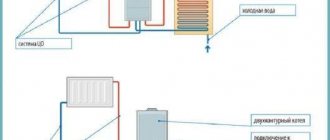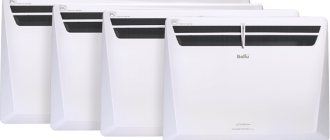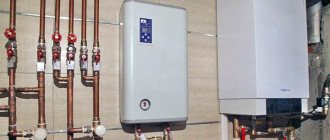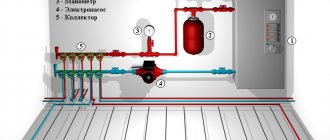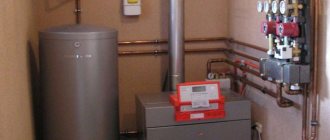What is convection?
The phenomenon of convection was taught at school as part of the physics curriculum. This is the transfer of energy by jets of liquid or gas. As you know, warm air always rises and cold air sinks. Another striking example is water that is heated in a kettle. When the cookware sits on a lit burner, the warmer liquid rises from the bottom, which ensures uniform heating overall. This process is called natural convection. Convection can also be forced. This is the work of a fan, pumps, etc., under the influence of which the transfer of liquids and gases occurs.
Electric heaters
This group of heating devices independently produces heat by converting electricity. The heart of the device is the same finned heat exchanger, only inside it, instead of pipes with water, a heating element is installed. The element is placed inside a metal case, where slots are made in the lower and upper parts for air passage. The electric convector is automated from the very beginning, since even the cheapest version is equipped with a thermostat that controls the operation of the heating element.
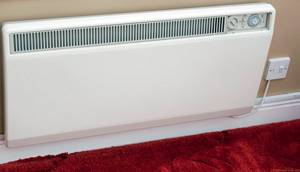
It should be noted that heating with electric convector heaters is not only convenient, but also effective. The efficiency of the devices reaches 98%, and a high degree of automation allows you to save electricity, this is achieved by programming the heater for different operating modes at certain times of the day. According to their design, electrical appliances are:
- wall-mounted;
- floor (mobile);
- baseboards;
- intra-field.
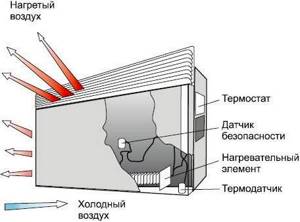
For reference. Several convectors can be combined into a common system controlled from one center, for example, a remote programmable unit with a thermostat.
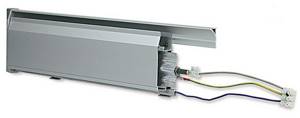
If you study all the reviews about such heaters, the negative is expressed only in one respect: it is expensive to pay for electricity. Otherwise, there are very few complaints, which is not surprising, because the price of the equipment and its installation is quite affordable for a wide range of buyers. There are also no problems with the heating speed; any convectors are famous for this.
What is convector heating called?
A convector heating system is a system in which heat is transferred from the heating element coolant through convection. That is, heat transfer is carried out by continuously moving air flows. Thanks to this, it is possible to heat the room evenly.
Heating is arranged as follows. Its main elements are convector heating radiators. At the bottom there is a heat exchanger in which a heated coolant constantly circulates, playing a major role in the heat exchange process. To make the contact area of cold air with the heater larger, it is equipped with flat metal ribs or tubes, which guide the flow of heated air.
Read our article about the pros and cons of fireplace stoves with a water circuit. Did you choose bimetallic radiators with bottom connections? Read how to choose here.
The whole truth about floor-standing, single-circuit, non-volatile gas boilers, see: https://prootoplenie.com/otopitelnoe-oborudovanie/kotlu/ehnergonezavisimye.html

Heating convector device
So, cold air enters the heat exchanger, which, when heated, moves upward.
One of the advantages of such heating is that the air in the room can be heated quite quickly.
Self-installation
You can install gas equipment in a private home with your own hands, but to do this you need to have all the necessary tools and have certain skills.
The following materials and tools are used during the work:
- metal-plastic pipe with fittings;
- pipe cutter;
- wrench;
- sanitary silicone;
- gas tap;
- perforator with a “spatula” crown;
- drill with drill bit;
- crosshead screwdriver;
- high-temperature polyurethane foam and silicone;
- dowels and screws made of plastic.
Stages of installation work:
- First you need to decide where the gas appliance will be installed. According to GOST, it is mounted under the window.
- The convector is fitted to the selected location. You can use a tape measure and transfer the dimensions, or simply attach the unit to the wall and mark the locations of future holes.
- Let's look at where the gas inlet is located. If at the bottom of the device, then you need to leave enough space for the supply of a pipe with a fitting.
- A hole is punched in the wall along the diameter of the exhaust pipe. This can be done with a hammer drill. This procedure is not only labor-intensive, but also dusty, so it is recommended to cover things with film in advance.
- Holes are drilled and dowels are hammered into them.
- The exhaust pipe is inserted into the convector. The joint should be treated with high-temperature silicone. After the pipe is inserted into the wall, the convector is secured using self-tapping screws.
- A gap is sealed between the pipe and the wall. This can be done conveniently using high-temperature foam.
- A special cap, included in the package, is installed at the end of the pipe. It prevents the burner from going out due to wind. Self-tapping screws are used to secure it.
Procedure for gas supply:
- The pipe leading to the heating device must be laid outside. This is the requirement of GOST. If the gas pipe already has a threaded connection, then just screw the tap onto it and shut off the gas supply to the convector. If there is no withdrawal, then one will have to be made. To perform this work, it is necessary to invite an electric and gas welder.
- After installing the gas tap, a metal-plastic pipe is connected to the convector. You can calculate its length using a tape measure.
- When laying the pipe, every meter should be secured with clips, for which you will need to drill holes in the wall.
- Installed fittings, like pipes, are lubricated with silicone, which provides additional sealing and facilitates installation work.
Now you need to check how the equipment works by doing a test run:
- The gas valve is opened and a soap solution is applied to all fittings and connections. Inflating bubbles will indicate a leak. If any are found, the tap should be turned off and the problem fixed.
- Next, the convector starts up. The gas supply button is pressed for about a minute, during which the gas will pass through all the pipes and end up in the combustion chamber.
- The piezo igniter is pressed, causing a spark to form in the firebox and ignite a flame.
- The device is adjusted so that the room temperature is comfortable.
At first after starting, you may notice an unpleasant smell of burning oil. This is normal - this is how the camera burns on new devices. If the smell persists for a long time, you need to check the quality of the joint between the exhaust pipe and the outlet of the device.
Types of convector heating
Depending on the energy used, convector-type heating radiators are:
- electrical;
- water;
- gas.
Electric convectors
This type of heating involves the use of electric convector radiators. Electric convectors are heating devices with optimized energy consumption. They are completely safe to use if they are made by a reputable company. Experts do not advise buying heating equipment from an unknown manufacturer, because this is fraught with a short circuit in the network and a fire.
Electric convectors use several types of heating elements. This:
- heating elements (tubular electric heaters);
- filaments;
- nichrome spirals.

Floor electric convector
The most progressive and safe model of electric convectors are those in which a heating element is installed. In such equipment, the filament is located in a steel tube. Heat is transferred through an aluminum radiator. The heat exchanger temperature does not exceed a safe 60 °C. Electric convectors with heating elements are called one of the safest electrical appliances.
The cheapest model is considered to be electric convectors with an open filament. However, they have a lot of disadvantages. Dust falling on the heating element burns and releases products harmful to humans. Health will not suffer if the room is well ventilated. But if only the hood is involved in the ventilation process, then problems cannot be avoided.
The most modern models of electric convectors have programmers that allow you to set the temperature even not every day of the week. Thanks to this component, not only energy is saved, but also comfort is increased. For example, if the house is empty during the weekday, the equipment will automatically lower the temperature. And by the time the owners arrive, the temperature will rise again. On weekends, the radiators will work smoothly all day. If there are other functions that provide convenient handling of heating equipment. For example, this is the ability to switch off after a fall.
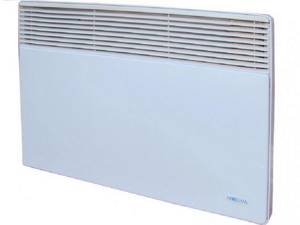
Wall-mounted electric convector
More complex space heating schemes are also used, when several devices are combined into one network. But at the same time, each convector can be assigned its own operating schedule.
For a very long time, the media has been discussing the question that during the operation of electric heating equipment of this type, positive ionization of the air occurs due to contact with heated metal. Manufacturers, in order not to argue with consumers, decided to equip some models of devices with ionizers and air purifiers.
The dimensions of electric convector radiators are quite compact. They can be attached to the wall or installed on special stands with wheels.
Advantages (ten):
- reasonable price;
- easy installation and operation;
- Efficiency is about 95%;
- heating element heats up quickly;
- quiet work.
Flaws:
- gradual decrease in efficiency and heating parameters over time;
- high energy consumption and high cost;
- ineffective for large rooms, acts as an additional means of heating;
- Some models burn oxygen and cause dust.
Gas convector heating
The operating principle of gas and electric convectors is the same. The only difference is in the method of heating the heat exchanger. You will have to tinker a little with gas equipment. It is connected to the gas main with a special hose. This requires additional expenses that pay off quite quickly. As you know, gas is one of the most affordable types of fuel, but provided that the home is connected to the main line. If liquefied gas is used, then the costs of convector heating at home can be equal to those when using electricity.
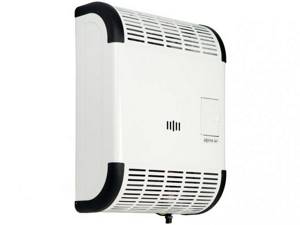
Gas heating convector
Gas convectors require an air supply and exhaust gas outlet. The arrangement of a coaxial flue makes it possible to combine these two functions. It is built on the “pipe-in-pipe” principle: combustion products are discharged through the internal channel, and air is taken in through the external one. This system also provides heat recovery.
How to disassemble an electric convector for home. Branded and inexpensive thermostat for Danfoss heating radiators. Read how to choose here.
Why do we need in-floor heating convectors at the link: https://prootoplenie.com/otopitelnoe-oborudovanie/%E2%80%8Bvodyanojj-konvektor.html
The most modern models of gas convectors have an automatic control system that has many of the functions present in their electric counterparts.
Advantages of gas equipment:
- safe operation;
- efficient heating at low temperatures.
Flaws:
- a chimney is required;
- high cost of gas.
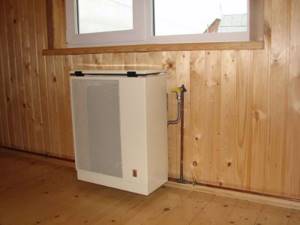
Gas convectors do not require a power source to operate unless they are equipped with a fan that accelerates air movement
Water convector heating
The main feature of water convectors is the coolant - water. This equipment has become the successor to traditional central heating, which is used in multi-storey buildings and is characterized by excellent heat transfer. This is the most economical type of heating.
Water heating convectors are:
- wall-mounted;
- - floor;
- built-in
Such radiators are connected to the heating system through special inputs. To regulate the heating temperature, modern models are equipped with dampers, water drain taps and valves that, if necessary, limit the flow of coolant.
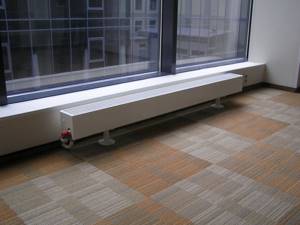
Water convector - an economical heating option
Advantages of water heating:
- operational safety;
- fast heating;
- ease of maintenance;
- light weight;
- cuts off cold air from outside if you place the radiator under the window;
- good results at low temperatures, relatively low power consumption.
Flaws:
- when air flows are unevenly distributed, drafts occur;
- ineffective in large rooms, especially if they have high ceilings.
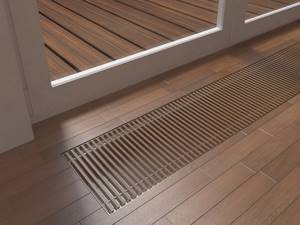
Underfloor water heating convector
Installation in a private house
The ease of installation of electric convectors allows you to implement this procedure yourself.
Before you make convector heating with your own hands, you need to prepare the following tools:
- Hammer.
- Screwdriver.
- Hammer.
- Level.
A wall-mounted electric convector is installed in the following sequence of operations:
- Assembling the device, during which it is necessary to secure all the brackets to the body.
- Fitting the structure to the wall surface: it must be leveled. During this, marks are made at the location of the brackets.
- The brackets must be removed from the panel and attached one by one to the applied markings. This makes it possible to mark points for drilling holes for fasteners.
- Using a hammer drill, holes are made in the marked places.
- Using a hammer, carefully hammer the dowels into the base.
- To screw the brackets, use a screwdriver or screwdriver.
- The instrument panel is hung on well-fixed brackets.
- To start operating the convector, it must be connected to the network.
When using electrical appliances, it is important to understand that such convector heating of the house will significantly increase the load on the network, so you should calculate in advance whether the old wiring will withstand this. To ensure heating safety, it is recommended to equip devices of this type with separate cable lines. https://www.youtube.com/embed/WZnvggq6oWI
Price and manufacturer's choice
Electric convectors of the simplest modifications can be purchased at a price of 2,100 rubles. As the level of functionality increases, the cost of the product also increases. Such equipment is present in the range of well-known manufacturers of household appliances that have long won the trust of consumers - Electroluxe, Scarlet, Polaris and others. Reviews about their convector heating batteries are mostly positive.
Gas convectors are presented online at prices starting from 12,300 rubles. These products are produced by ATON, Hosseven, Gorenje, Alpine, Karma.
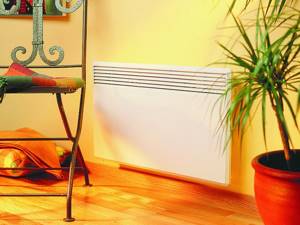
The prices for these convector heating batteries vary depending on where the equipment is installed. Roughly it is like this:
- floor convectors 80x250x500 mm with heat output 330 W – 1800 RUR;
- built-in convectors 85x800x200 mm – 3240 RUR;
- wall convectors 60x400x500 mm – 1650 rub.
This type of equipment is marketed under the brands Kifato, EVA, etc.
What types of convectors are there?
Based on the principle of working with energy carriers, there is a wide selection of such equipment. But now most convectors sold in stores have an electric heater. There are models that run on gas - gas convectors.
Electric convectors are best suited for heating apartments because they are compact in size. Convector heating of a dacha or country house is more profitable to operate, creating it on the basis of gas convectors - gas is much cheaper. Of course, provided there is gas in the house.
According to the installation method, convectors can be divided into:
- Floor-standing;
- Wall-mounted;
- Mounted into the floor or baseboard.
- Floor convectors are installed on the floor, may have wheels for moving along the floor surface, or can be rigidly installed, without the ability to move. Photo with a floor convector is just below.

Floor convector
- Wall convectors for heating are mounted directly on the wall using special brackets.
- The third type of convectors can be mounted into the floor or into the floor plinth.
Advantages and disadvantages
A modern water heating convector is considered an effective option, but has one main drawback - it cools down quickly. Therefore, in winter, it is necessary to constantly maintain the supply of hot coolant if a local boiler is installed in the house. First of all, it is worth touching on the advantages:
- The ability to create thermal curtains in front of panoramic windows, which eliminates the formation of condensation in winter.
- Efficient heating of rooms of any size.
- Low weight allows you to install convection water heating radiators on plasterboard panels.
- Models are built into the floor if necessary.
- Full compliance with modern fire safety requirements, since the heating element is placed in a special housing.
- Large selection of types and sizes, each with a unique design.
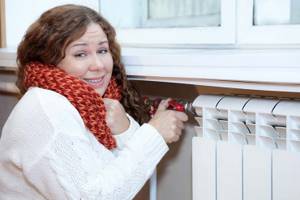
There are a minimal number of disadvantages, and they are all related to the size and dimensions of the equipment and premises. One can hope for high efficiency and the installation of auxiliary fans, but the disadvantages remain. Main disadvantages:
- Inability to heat rooms with high ceilings. Very often it is necessary to install several convectors with forced air supply.
- The cost is higher than standard radiators.
- Large dimensions.
The last point is offset by the ability to install equipment on the floor. Each model is unique in its own way and has its own technical characteristics. When purchasing, it is recommended to take into account the possibility of using the convector in a specific room. To do this, you need to indicate the area and height of the ceilings in the room, based on this, the consultant will select the appropriate option.
Installation of wall convectors:
Principle of operation
The category of heating equipment under consideration has several main features. This applies not only to the design of the body, but also to the operating principle, which is significantly different from the cast iron versions. It is as follows :
- It is recommended to use antifreeze or water as a coolant.
- The design has two grilles located at the top and bottom. The air passes through the lower unit and the heating system. Thus, it becomes lighter and strives even higher. This is convection.
- The process is cyclical, warm air is constantly replaced by cold air due to its physical parameters.
See also: antifreeze for heating systems of private houses.
Convectors heat the room faster compared to cast iron radiators. The continuous process also creates an effective thermal curtain, or “wall.” When developing building projects, such equipment is installed along cold walls or panoramic windows, which minimizes heat loss and creates comfortable indoor conditions.
Heating radiators – which ones are better:
Types of electrical appliances
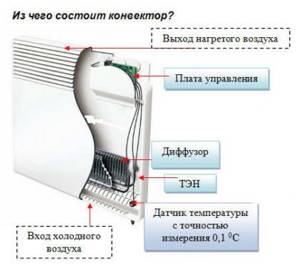
Convectors are divided into several types, depending on the type of installation:
- floor;
- universal;
- wall;
- built into the floor
Any type of electric convector is suitable for heating a dacha, but the features of all types should be taken into account.
Floor-standing
convectors are mobile, they can be moved from one room to another. Such models will be an excellent solution if there is no access to the walls. Floor convector heaters are often equipped with an automatic shut-off function when tipped over. An additional advantage is that they can be transported home if no one lives at the dacha in winter.
Wall mounted
, as well as universal convectors, are convenient because they do not take up space on the floor and do not create the typical inconveniences that floor-mounted ones do. The relatively low temperature of the surface of the housing will allow you to install the device without fear of damaging the decorative finish of the walls. The package of universal convectors includes legs or rollers for floor placement and brackets for wall mounting.
Built-in
heaters are installed only during construction or renovation of the floor; for their installation you need a niche with a depth of about 20 - 25 cm. This is a stationary type of heating electrical appliances, more often used in commercial premises: shopping centers, showrooms, exhibition halls. They are especially often used in rooms where the walls are made entirely of glass.



